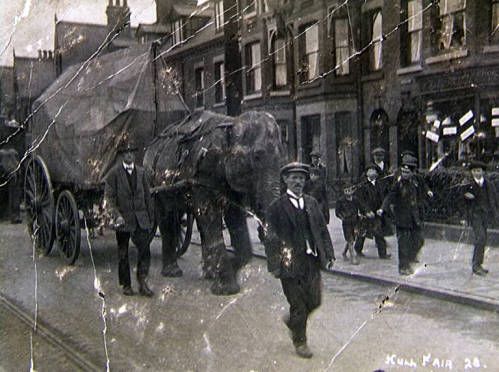Archeologists are looking for the skeleton of an elephant – not in the savannahs of Africa or the jungles of Asia, but in the green English countryside.
In Victorian Britain, traveling menageries would scale up and down the country to show off the exotic animals looted from the empire’s distant lands, including lions, tigers, bears, camels, and elephants. Legend has it that one elephant from a traveling show was buried in 1891 somewhere around Kingswood, South Gloucestershire.
In the hope of shedding light on this mystery, the local council has recently commissioned Wessex Archeology to help find its colossal grave.
The elephant is said to have died after eating poisonous yew leaves and was buried somewhere in the vicinity of Whitefield’s Tabernacle or Holy Trinity Church. Since no official records of its burial exist, the search for its giant grave is wide, so archeologists will be using geophysical surveys to scan large areas of land.
“Searching for Victorian elephant burials isn’t our usual fare but a grave of that size would leave a large hole and would certainly be identifiable with the Ground Penetrating Radar equipment we will be using to survey the site,” Tom Richardson, Terrestrial Geophysicist at Wessex Archaeology, said in a statement sent to IFLScience.
The elephant in question was part of Bostock and Wombwell’s Menagerie, which a local newspaper reported was in South Gloucestershire in February 1891:
“Bostock’s Grand Star Menagerie […] will take up its quarters on Friday on the open space near Lawrence Hill station, where it will remain for 8 days […] Among the larger animals in the collection is Nancy, a fine nine-year-old elephant, four camels, ten or a dozen fine lions and lionesses, three Bengal tigers, a sacred Indian bull, agnu [sic] or horned horse, some leopards, polar and brown bears, a hyena, and a pack of Russian wolves […] The animals are all in splendid condition.”

A traveling menagerie and an elephant wander down a Victorian street.
Image credit: The National Fairground and Circus Archive/The University of Sheffield
Inspired by Romantic ideals of the natural world and the burgeoning concept of Darwinism, the Victorians were fascinated with nature, albeit in a clinical and somewhat removed way. Menageries, where rare and wonderful animals were kept in cages and chains, became hugely popular in the era as a form of both education and entertainment.
“During the 19th century, the fascination with the natural world allowed both traveling and static menageries to flourish. People wanted to experience exotic and strange animals. Seeing these creatures was seen as educational, indeed the government actively encouraged families to take their children. But merely viewing them was not enough; the public also wanted to be entertained. In some menageries, animal keepers began to perform tricks with their beasts, especially with the large carnivores and elephants,” explains Dr Steve Ward, a social historian who’s written extensively about the history of the circus.
Given the lax attitude to animal welfare in centuries gone by, the excavations of the elephant’s skeleton have the potential to uncover some unsavory insights.
“In the case of a menagerie elephant, as well as understanding where the animal came from and its age, we may be able to see the impact of its life as an entertainer, this may include evidence of confinement including trauma from shackling the animal or arthritis. It may also be possible to detect injuries or strains resulting from its performance duties, such as repetitive movements,” added Lorrain Higbee, a zooarchaeologist at Wessex Archaeology.
Source Link: Search Begins For Bones Of Legendary 19th-Century Circus Elephant